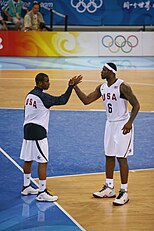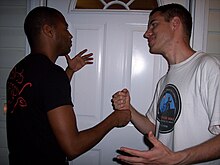
Dap or the dap is a friendly gesture of greeting, agreement, or solidarity between two people that has become popular in Western cultures, particularly since the 1970s, stemming from African American soldiers during the Vietnam War. Giving dap, dapping, or dapping up typically involves handshaking (often by hooking fingers), pound hugging, fist pounding, or chest or fist bumping.
Giving dap can refer to presenting many kinds of positive nonverbal communication between two people, ranging from a brief moment of simple bodily contact to a complicated routine of hand slaps, shakes, and snaps. If known only by its two participants, it can be considered a secret handshake. Elaborate examples of dap are observed as a pregame ritual performed by many teams in the National Basketball Association, serving as a means of psychological preparation and team solidarity.
History
Vietnam War
Main article: Military history of African Americans in the Vietnam War § Solidarity
The practice and term originated among black soldiers during the Vietnam War as part of the Black Power movement. Ninety percent of those imprisoned in the Long Binh Jail during the war were African Americans; it was in the jail that the handshake was created under pan-African nationalist influences.
Its main use was to instill solidarity among black American soldiers, conveying their commitment to look after one another. This was a response to the racism black Americans faced during Vietnam War deployment, including several cases of white soldiers shooting fellow black soldiers during combat. It sometimes contained information "such as what to expect at the battlefront or what had transpired during an operation". White military officials feared the handshake, believing the coded language included plans for a potential black insurrection. Due to these fears, military officials banned dapping, and "many black soldiers were court-martialed, jailed, and even dishonorably discharged as a punishment for dapping". However, the censorship only solidified the need for unity among black American soldiers.
Despite the suppression of the dap, the military later used dapping to increase trust for black combatants with post-traumatic stress disorder who needed medical treatment. Officers "would bring in black G.I.s fluent in the dap to dap with these men to build their trust up to accept treatment from white doctors and staff".
Contemporary
In 2013, American photographer LaMont Hamilton created Five on the Black Hand Side, a photo series depicting African American men's handshakes as they perform the dap. The name of the project is likely comes from a clapping game. Combining the photographs with oral histories, Hamilton noted his discovery that "there is a tremendous diversity of daps, evolving from the dramatically different movements and meanings of each military company".
Etymology
The etymology of dap is uncertain, and there are various theories. Most simply, it may be imitative (compare tap, dap), and is sometimes explained as an acronym for dignity and pride, possibly a backronym.
References
- Green, Lisa J. (2002). African American English: A Linguistic Introduction. Cambridge University Press. p. 144.
- Sargent, Scott (May 2013). "The Secret World of NBA Daps". SB Nation. Retrieved May 1, 2013.
- Dalzell, Tom (2009). The Routledge Dictionary of Modern American Slang and Unconventional English. Taylor & Francis. p. 271.
- ^ Hamilton, LaMont (September 22, 2014). "Five on the Black Hand Side: Origins and Evolutions of the Dap". Smithsonian Center for Folklife and Cultural Heritage. Archived from the original on September 16, 2016. Retrieved 2018-10-25.
- Zinn, Howard (2008). A People's History of American Empire. New York: Metropolitan Books. ISBN 9780805077797.
- ^ Hamilton, LaMont (22 September 2014). "Five on the Black Hand Side: Origins and Evolutions of the Dap". Smithsonian Center for Folklife and Cultural Heritage. Retrieved 2023-12-20.
- Wells, Leslie (2023-02-13). "On the Black Hand Side". Making a Difference. Retrieved 2023-12-20.
External links
- Video of dap greetings archived at Ghostarchive.org on 27 April 2022
| Gestures | |
|---|---|
| Friendly gestures | |
| Gestures of respect | |
| Salutes | |
| Celebratory gestures | |
| Finger-counting | |
| Obscene gestures | |
| Taunts | |
| Head motions | |
| Other gestures | |
| Related | |
This culture-related article is a stub. You can help Misplaced Pages by expanding it. |